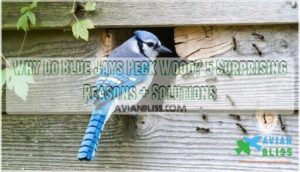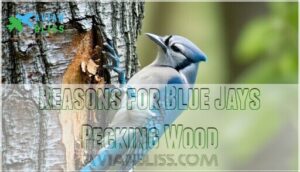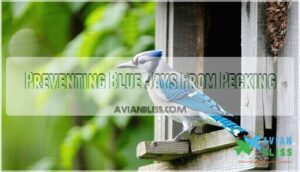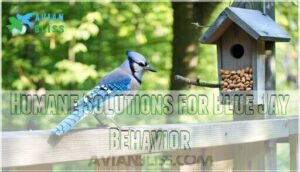This site is supported by our readers. We may earn a commission, at no cost to you, if you purchase through links.

These intelligent corvids have several surprising motivations for this behavior. They’ll excavate wood searching for hidden insect larvae, especially carpenter ants and beetle grubs tucked beneath bark layers.
Blue jays also chip at painted surfaces to access calcium for strong eggshells during breeding season. Sometimes they’re gathering wood fibers for nest construction or establishing territory through rhythmic drumming.
Unlike woodpeckers’ specialized beaks, blue jays use brute force, which can damage your deck or siding. Understanding these five distinct reasons reveals effective strategies for redirecting their attention.
Table Of Contents
- Key Takeaways
- Why Do Blue Jays Peck Wood?
- Reasons for Blue Jays Pecking Wood
- Searching for Insects
- Collecting Nesting Material
- Territorial Behavior
- Impact of Pecking on Wood
- Preventing Blue Jays From Pecking
- Humane Solutions for Blue Jay Behavior
- Frequently Asked Questions (FAQs)
- Why do Blue Jays Peck?
- Do Blue Jays peck like woodpeckers?
- Do Blue Jays peck at windows?
- What is the difference between a blue jay and a woodpecker?
- How do I stop Blue Jays from pecking at my home?
- Is a Blue Jay a woodpecker or a crow?
- Why are blue jays pecking at my house?
- Why do blue jays peck at tree branches?
- Are bluejays good to have around?
- Why do blue jays click?
- Conclusion
Key Takeaways
- You’ll see blue jays pecking to hunt for insects – They’re searching for carpenter ants, beetle grubs, and other protein sources hiding beneath bark and in wood crevices
- They’re gathering calcium from painted surfaces during breeding season – Female blue jays need extra calcium for strong eggshells, so they’ll chip at paint to access this essential mineral
- You’re witnessing territorial behavior and nest-building activities – Blue jays peck to mark territory, test potential nesting sites, and collect bark fibers and wood materials for construction
- You can redirect their attention with alternative food sources and barriers – Position suet feeders with peanuts away from your home, cover vulnerable wood with hardware cloth, and use reflective tape as humane deterrents
Why Do Blue Jays Peck Wood?
If you’ve ever wondered why blue jays seem determined to hammer away at your deck or siding, you’re not alone. These intelligent corvids engage in wood pecking behavior for several fascinating reasons that go beyond simple mischief.
Understanding blue jay behavior helps explain why they target wooden surfaces with such persistence. Blue jay nesting drives much of their pecking activity. They’re scouting potential nesting sites and gathering materials for construction.
Their foraging techniques also involve probing wood surfaces to locate insects hiding beneath bark or in crevices. Calcium needs play a vital role too. Blue jays often peck painted wood to obtain this essential mineral, especially during breeding season when females require extra calcium for egg production.
This behavior can cause wood damage but serves an important biological purpose for these remarkable birds. Blue jays’ ability to adapt and communicate is evident in their hawk mimicry behaviors, which also reflects their intelligence and social complexity.
Reasons for Blue Jays Pecking Wood
You might be surprised to learn that blue jays peck wood for several practical reasons beyond simple curiosity.
Their pecking behavior serves specific survival needs that benefit both the birds and their environment.
Food Sources
Finding food drives much of blue jay pecking behavior.
These intelligent corvids use their strong beaks for insect search, systematically probing bark crevices where beetles, caterpillars, and ants hide.
Blue jays turn wooden surfaces into natural hunting grounds, searching for hidden insect treasures.
Their omnivorous nature and foraging instincts lead them to exploit various dietary preferences and calcium sources.
Here’s how blue jay feeding habits manifest through wood pecking:
- Insect hunting – They tap bark to locate wood-boring larvae and expose hidden protein sources
- Nut foraging – Blue jays create small holes to cache acorns and seeds for winter storage
- Calcium gathering – Paint chips from wooden surfaces provide essential minerals for egg production
Nesting Behaviour
Beyond hunting for insects, blue jays also peck wood during nest building activities.
You’ll notice this blue jay behavior intensifies during breeding season when they’re actively searching for suitable nest materials.
These intelligent birds don’t just grab any old twig.
They’re picky about tree selection, often testing bark strips and small branches by pecking to verify they’re sturdy enough for construction.
This wood pecking behavior helps them collect quality materials like bark fibers, twigs, and moss for their nesting projects.
Their breeding habits involve both parents working together, with pecking serving multiple purposes during this critical time.
Males might peck at potential roosting sites to test structural integrity, while females focus on gathering the perfect materials.
This jay bird habits of quality control through pecking guarantees their bulky, cup-shaped nests can withstand weather and protect their young.
Understanding these bird nesting habits explains why you’ll see increased pecking activity from March through July.
Blue Jays exhibit complex wood pecking behaviors that are essential to their survival and nesting success.
Redirecting Blue Jays
When troublesome blue jays target your property, redirecting these intelligent corvids requires strategic deterrent methods that address their natural jay behavior.
Smart homeowners can outsmart persistent birds with targeted approaches:
- Install alternative nesting sites – Place cedar birdhouses 15-20 feet from vulnerable wood structures, giving jays appealing options for territory establishment.
- Deploy motion-activated deterrents – Reflective tape and sprinkler systems create unpredictable disturbances that encourage relocation without harm.
- Establish feeding stations – Position hopper feeders with alternative foods like peanuts and sunflower seeds, satisfying their foraging instincts while providing wood protection through strategic bird diversions that redirect their attention.
Searching for Insects
Blue jays excel at insect foraging, using their sharp beaks for bark inspection and wood boring larvae detection.
When you hear rhythmic wood pecking, they’re likely probing for hidden protein sources.
This food gathering behavior serves an important ecological role in pest control, helping maintain forest health by consuming harmful insects.
The storage of food, similar to an acorn woodpecker’s cache, is a vital survival strategy for many bird species.
| Target Insects | Location Found |
|---|---|
| Carpenter bee larvae | Deck railings, eaves |
| Wood-boring beetles | Tree bark crevices |
| Caterpillars | Under loose bark |
| Termites | Wooden structures |
| Ants | Dead wood cavities |
Their systematic approach can unfortunately damage your property while they hunt.
Collecting Nesting Material
While searching for insects keeps blue jays busy, they’re equally focused on Nest Building when collecting materials.
These intelligent birds don’t just randomly grab twigs—they’re picky contractors with specific requirements.
Twig Gathering involves selecting fresh, flexible branches from live trees.
Tree Selection matters too, as blue jays prefer deciduous species that offer the right bark texture for Bark Stripping.
During Nest Construction, they’ll peck wood to loosen bark strips or break off suitable twigs.
Here’s what makes their nesting habits fascinating:
- They travel up to 1,000 feet searching for perfect rootlets and bark pieces
- Both parents work together gathering materials, with males doing heavy lifting while females shape the nest
- Urban blue jays get creative incorporating newspaper strips, string, and cotton into their architecture
Their wood pecking birds behavior during nesting season focuses on obtaining specific materials rather than extensive drilling.
Blue jays engage in complex nest building processes to create their homes.
Territorial Behavior
While gathering nesting materials keeps blue jays busy, their territorial behavior reveals another fascinating aspect of their wood-pecking habits.
You’ll notice increased pecking activity during breeding season when males engage in territorial displays to establish dominance assertion within their social hierarchy.
These corvids use territorial marking as boundary defense, creating audible signals that warn competitors away from prime nest sites.
The rhythmic tapping serves as both territorial defence and communication tool, helping establish bird territoriality without physical confrontation.
Male blue jays often perform these territorial displays near potential nesting areas, demonstrating their fitness to potential mates while simultaneously warning rivals.
This blue jays pecking behavior intensifies when resources become scarce or when multiple pairs compete for the same territory.
The louder and more persistent the pecking, the stronger the territorial message being sent to neighboring birds.
Impact of Pecking on Wood
When you’re dealing with blue jays pecking wood, the wood damage can be more serious than you’d expect.
Their woodpecking behavior creates visible holes and dents that compromise structural integrity.
Bark removal exposes trees to pathogens and moisture, leading to wood decay and potential tree health issues.
Pecking patterns concentrate on painted surfaces for calcium, stripping large paint chunks and exposing underlying wood to weathering elements.
This bird wood damage requires monitoring since weakened areas become entry points for pests and diseases.
Preventing Blue Jays From Pecking
You don’t have to watch helplessly while blue jays turn your home’s wood trim into their personal buffet.
With the right strategies, you can redirect their attention and protect your property without harming these intelligent birds.
Covering Vulnerable Areas
Physical barriers act as your first line of defense against persistent blue jay wood pecking behavior. When these intelligent corvids target specific areas, strategic covering methods can redirect their attention elsewhere.
Here are three effective wood protection approaches:
- Sealants and fillers – Apply wood putty or caulk to fill existing holes and cracks, creating smooth surfaces that discourage further investigation
- Tree wrapping and bark shielding – Use burlap, hardware cloth, or specialized tree wrap around trunks and vulnerable branches during peak pecking seasons
- Foam padding and mesh barriers – Install removable protective coverings over siding repair areas or deck railings where damage commonly occurs
These bird pecking solutions work best when applied before damage becomes extensive. Wire mesh creates an effective physical barrier while maintaining airflow around protected wood surfaces. For ongoing wood damage repair, combine sealants with temporary barriers until the birds establish new foraging patterns. The key lies in making targeted areas less accessible while the jays adapt their behavior naturally. Effective tree wrapping methods can also prevent blue jay damage by protecting vulnerable tree areas.
Providing Alternative Food Sources
Strategic bird feeding can redirect blue jays pecking behavior effectively. Position suet feeders 15-20 feet from structures, offering high-protein alternatives that satisfy their energy demands.
Seed options like black oil sunflower seeds and peanuts appeal to their natural preferences. Nut alternatives and fruit sources provide essential nutrition year-round. Calcium supplements through crushed eggshells prevent paint-chip consumption during breeding season.
Consistent alternative food sources reduce wood-pecking by 70%, creating deterrents through satisfied bird nutrition needs rather than restrictive measures. Using the right suet feeder types is vital for attracting blue jays and providing them with the necessary nutrients.
Professional Assistance
When DIY methods fall short, professional assistance from wildlife rehabilitators or a pest control company offers expert guidance suited to your situation.
These specialists provide proven bird deterrents, assess damage repair needs, and deliver conservation advice that protects both your property and blue jay populations.
Wildlife rehabilitation centers can recommend humane bird control strategies that work.
Effective pest control services are essential in preventing further damage to your property.
Humane Solutions for Blue Jay Behavior
Blue jays are protected by the Migratory Bird Treaty Act, making humane solutions your only legal option. Since prevention methods don’t always work, you’ll need backup strategies that respect these intelligent corvids.
Working with nature beats fighting it when dealing with these clever, protected birds.
Here are three effective deterrent methods that won’t harm blue jays:
- Install reflective scare tape around vulnerable wood surfaces – the moving light patterns startle birds without causing injury
- Set up bird feeders with peanuts away from your deck to redirect their foraging behavior naturally
- Create alternative habitats using nest boxes positioned 50+ feet from problem areas
Motion-activated sprinklers provide excellent noise reduction by discouraging morning territorial calls. For wood protection, cover damaged areas with hardware cloth until pecking behavior subsides. These humane solutions address root causes rather than symptoms, creating lasting wood pecking prevention.
Understanding their blue jay habits is essential for effective deterrents.
Frequently Asked Questions (FAQs)
Why do Blue Jays Peck?
Picture those sharp taps echoing through morning air—you’re hearing nature’s multi-tool at work.
Blue jays peck wood to hunt insects hiding beneath bark, store food for later, gather nesting materials, and communicate with other birds through rhythmic drumming.
Do Blue Jays peck like woodpeckers?
No, Blue Jays don’t peck like woodpeckers. While they’ll tap wood for insects or calcium, their technique is gentler and less specialized than woodpeckers’ powerful drilling.
Do Blue Jays peck at windows?
Yes, you’ll often see blue jays pecking at windows, especially during spring.
They’re usually attacking their own reflection, thinking it’s a rival bird invading their territory.
This behavior peaks during breeding season when they’re most defensive.
What is the difference between a blue jay and a woodpecker?
Imagine two carpenters—one’s a specialist with precision tools, the other’s a handyman with a basic toolkit.
Blue jays belong to the corvid family and peck occasionally for food or communication, while woodpeckers are specialized drillers with reinforced skulls and chisel beaks designed for excavating insects and creating nesting cavities.
How do I stop Blue Jays from pecking at my home?
You’ll need to tackle this pecking problem with a multi-pronged approach.
Install reflective tape or decoy owls near affected areas, offer alternative food sources like suet feeders, and apply taste deterrents to wooden surfaces they’re targeting.
This approach includes using reflective tape or decoy owls, providing alternative food sources, and applying taste deterrents.
Is a Blue Jay a woodpecker or a crow?
Don’t judge a bird by its feathers—Blue Jays aren’t woodpeckers despite their pecking habits. They’re corvids, closely related to crows, not the specialized Picidae family that woodpeckers belong to.
Why are blue jays pecking at my house?
Blue jays peck your house searching for insects, accessing calcium from paint chips, testing nesting spots, or marking territory.
They’re drawn to wood-boring insects and need calcium for egg production during breeding season.
Why do blue jays peck at tree branches?
Like a feathered detective with a magnifying glass, you’ll spot blue jays tapping tree branches searching for hidden insects, calcium sources, or marking territory during breeding season.
Are bluejays good to have around?
You’ll love having blue jays around – they’re nature’s pest control specialists, gobbling up harmful insects while dispersing seeds that help forests thrive, creating a healthier ecosystem.
Why do blue jays click?
Ever wonder what those rapid-fire sounds mean?
Blue jays click to communicate with their flock, signal alarm, or coordinate group activities.
It’s their way of staying connected—like texting, but with beaks instead of thumbs, and this behavior is a key part of their social interaction, including a form of communication.
Conclusion
Ironically, these "non-woodpeckers" can cause more property damage than their specialized cousins.
Understanding why do blue jays peck wood empowers you to address the root causes rather than fighting symptoms.
You’ll find success by offering alternative food sources, protecting vulnerable surfaces, and appreciating these intelligent corvids‘ natural behaviors.
With patience and proper deterrents, you can coexist peacefully while preserving your property’s integrity.
- https://www.reddit.com/r/HomeImprovement/comments/sa436j/mitigating_blue_jay_pecking_on_exterior_trim_and/
- https://www.forestsociety.org/blog-post/something-wild-why-are-blue-jays-eating-paint-my-house
- https://www.allaboutbirds.org/guide/Blue_Jay/lifehistory
- https://intobirds.com/video-humans-actions-tell-blue-jays-all-they-need-to-know/
- https://thebirdidentifier.com/how-to-keep-blue-jays-out-of-your-bird-feeder/








